#glyph combos
Explore tagged Tumblr posts
Text
Building a Canon-Compliant, Consistent and Comprehensive Scheme for Constructing Glyph Combos
Tl;dr: Yes, I did cram as much alliteration into that title as possible. Anyway, I set out to create my own system for making glyphs from scratch, using the basic concepts we’re shown in the show, here is my thought process all laid down along with the results. Since this has expanded over time to become a monstrous dissertation, the layout for this will be Basic Concepts, where all the basic concepts from the show are listed as the foundation for this system, followed by Basic Vocabulary, where the words for the glyph ‘language’ are made up, proceeded by Grammar Rules, where I think up the rules of the system and use what I’ve got so far to analyse the simpler combo glyphs made by Luz and co. The penultimate section is Shortcuts and Misc. Stuff, where I take a look at Philip’s WIP glyphs (seen at the start of Them’s the Breaks, Kid), attempt to figure out what they could mean in this system to yield the canon effects, and work in the miscellaneous stuff that appears on them. And lastly Conclusion, where I use this system to build a glyph combo from scratch for a spell that appears in the show.
Also, here's an Imgur album for every illustration coming up in this post.
I’ve gone pretty deep into this, so if something that I think makes perfect sense makes absolutely no sense to you, please comment and ask for clarification or something. Also, if you know of another system someone made for this, I couldn't find it, so I'd love to see those as well.
Quick note before I begin: This literal essay is not me attempting to figure out how the actual system within the show works. To be honest, I don’t even think there is a fully worked-out system behind the scenes. Glyph combos were highly underutilised in the show, especially compared to single-glyph usage, so there wouldn’t be much point in building an entire system of rules for constructing them if you’d only need to use it in a few instances. Instead I think the crew simply put together some glyphs that intuitively felt like they’d work for the few glyph combos we do get, and then added some extra doodads for each to hint at the existence of a complex ruleset that would allow for four glyphs to reproduce every possible spell.
So yeah, I’m not setting out to make a system that perfectly explains every glyph combo we see, especially the advanced ones Philip uses (it feels weird to say Belos is using glyphs, dunno why). You certainly won’t see me crying in bed after this if what I come up with doesn’t fit perfectly with everything. Instead I’ll be taking the basic concepts the show has laid out for us, take some aspects/cues from the show’s glyph combos, and build a system with that for my own needs (I’m writing a crossover with Harry Potter and I want to have a consistent system for turning HP spells into glyph combos). Though I will at least attempt to budge things around to have the simpler glyph combos work out with whatever I come up with, and I’ll also see how closely I get the more complicated combos once that’s done. If things do happen to work out, then consider me a happy guy.
(Edit from me after having written everything out, about a day later: I did actually manage to read all the glyph combos from the show and get a meaning that corresponds to what happens in canon, so that was a very pleasant surprise. Except the teleportation glyph. I’m not even going to attempt reading it so I don’t actually know if that one would work with this system or not. But hey, here’s a nice prospect to look forward to if you attempt reading what has become a dissertation lol: some actual decent results).
Update: I removed the redundant secondary elements from the 2- and 3-mergers and added more useful ones.
Basic Concepts
Let’s list the basic concepts we can use from observing the show first.
a.1) There exist four basic glyphs, each with an elemental meaning: Light, Ice, Plant, and Fire. Though I’d like to say that Life is a more accurate descriptor for Plant, just that plants are the easiest living things to imagine and grow when using it (And growing sentient things might be a bit iffy).
a.2) There also is a fifth sorta glyph that I'll call a Null glyph, which has a glyph border but no symbol inside. Philip used it in his most complex glyphs and Luz used it in her mist generating glyph.


I think a glyph that has no meaning on its own can be quite useful as a building block, either when a glyph is needed somewhere but you don’t want to use any of the actual glyphs, as a way to indicate absence, or as a place to input external variables (Interesting fact, on the golden glyph bubble thing Luz conjured as a Titan-hybrid there are five connected glyphs evenly spread out over it. You can see Light, Plant, and Fire most of the time, with Ice visible below as one of the two obstructed glyphs later, leaving the final one as Null if the trend of no repeats continues).

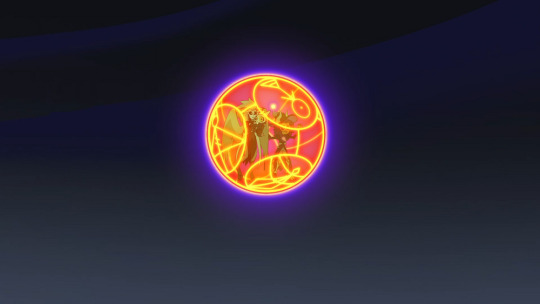
b) Glyphs can have small variations to their symbols, changing their effects slightly. Glyphs can also have a single or double border.
c) While size determines the power behind a glyph’s effect, intent also plays a large role, primarily in how and when a glyph activates, where/on what it generates its effect, and what shape and direction its effect has.
d.1) Glyphs can also have secondary meanings, which are related to their element. The only examples we get are Power, Colour and Reflection for the Light glyph (from the notes near the start of Echoes of the Past), though judging by the question marks they weren’t sure if those were the right words either, and Reflection fits less with Light and more with Ice imo.
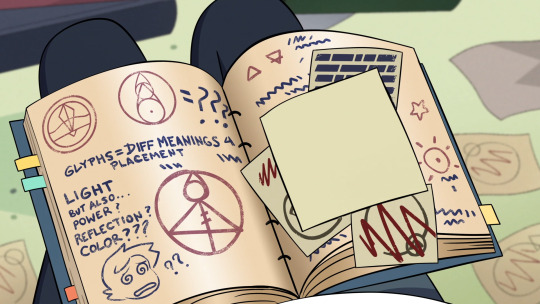
d.2) We also know which meaning a glyph has ‘diffs 4 placement’, whatever that means.
e.1) Glyphs can be chained together into closed circuits, which can technically be any shape (rectangular in Luz’s neon shop sign) but are preferably circular. This allows for glyphs to be activated simultaneously.
e.2) Chaining multiples of the same basic glyph together allows for multiple separate instances of the same element to be summoned simultaneously.
e.3) Putting two different glyphs in a circuit can yield a new, merged, secondary element (like Doodle God or Little Alchemy or whatever floated your boat back then), the only known example from the show being Mist from Fire and Ice.
e.4) The basic glyphs are always drawn in the same orientation within glyph combos, with one known exception that I’ll ignore because it occurs in the teleportation glyph.
f.1) Glyphs are like a language that describe what you want the ambient magic to do, with the basic glyphs being the words and circuits being the sentences, though this seems distinct from how circuits function from e.2. This also seems to be closer to a natural language than something like a coding language, as there’s an actual being that you talk to which casts the magic for you (I’m assuming that using glyphs communicates telepathically with a subconscious part of Papa Titan’s soul, since it stops working once his soul isn’t there anymore to respond and use his magic in the way the glyphs instruct him to. I’m also saying his subconscious because having him consciously hear and act on magic instructions would be hell).
f.2) Context clues, synonyms, metaphors and subtext thus play a role in reading glyphs, as they do with natural languages. Though with intent added to the mix to disambiguate, though you can't just press a single glyph and expect your intent to do everything (God, wouldn’t it be nice if sending intent along with what you say was a thing we could do. So many avoided miscommunications).
f.3) Glyphs overlapping will cause confusion and glitches in the language, like overlaying text or saying words at the same time.
g) With these 4(/5) basic glyphs, chaining glyphs in circuits, and whatever rules, secondary elements from merging, and secondary meanings of glyphs exist, you can reproduce any spell a Boiling Isles witch can cast.
And with that out of the way, let’s get started.
Basic Vocabulary
First things first, a vocabulary of only four words (a.1) is far too little to make a decent system out of, so it’s a good thing we have point d.1 to take from. Sadly we’re seriously lacking in any confirmed secondary meanings to have a decent vocabulary, so I’ll already have to resort to thinking up my own. See below what I've come up with.
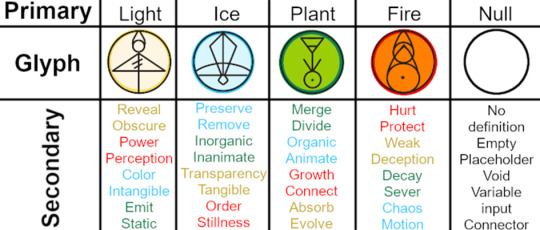
For the four basic glyphs I added four sets of pairs of secondary meanings. To add my own twist and to make things feel more cohesive, each meaning is paired up with an opposite, colour-coded here with the glyph it’s paired up with. Three sets of pairs are paired up with meanings from one of the three other glyphs, and the fourth set is a pair of opposites from the same glyph.
And since this acts as a language (f.1) we should also add in the ability to use word types. In this case, nouns, verbs, adjectives and adverbs. From the word types, pronouns aren’t needed, and prepositions and conjunctions can be figured out through context or some indicator. So, for each meaning we can add the noun, verb, adjective and adverb variations where it’s possible in the above. And let’s also add the ability to use close synonyms when needed (f.2). Like Evolve being interchangeable with Change or Transform as a verb. Or the noun version of Obscure, Obscurity, being interchangeable with Secret. The intent of the user and context can be what decides which synonym is used (c).
Speaking of, we also need a way to indicate which form of word is being used for each glyph, so let’s bring in point b for this.

Let’s have the standard design of the glyph symbols indicate a noun, and the variant design of the symbols can indicate a verb (changing direction of diagonal stripes for Light, the kite to triangle for Ice, and the dot to small circle for Plant and Fire), and I’ll also add a use for the double border, which I’ll call the ad-der, since I’ll have it change the noun design into its adjective meaning and the verb design into the adverb version (it would’ve fit better if nouns were called jectives, or adjectives were called adnouns, but we can’t have everything). This probably won't perfectly match up, especially since some glyphs have more alternate designs, but that's a concession I'll make.
Also, just ignore how the secondary meanings in the first table aren’t all in noun form, I just put in what type of word fit best, but assume that the noun version applies to the standard design.
Now we have a small vocabulary built up, but from first glance it’s still missing a bunch of useful words that we’ll want this language to have to describe every spell (g), and only using words related to one of the elements will always keep this limited, even if you add more.
So let’s pull in point e.3 and see what words we can come up with when merging the four elements. Once again this will require coming up with things from scratch, since the only confirmed case is Fire and Ice into Mist. See my confusing attempt at a table below.

Since using multiples of the same glyph just allows for getting multiples of the same effect (e.2) I kept those combinations out. And since I want as extensive a vocabulary as possible, let’s allow for the order of combining elements to be important as well.
With the only instance of merging elements being with two, I’ll take the opportunity and make three-mergings possible as well, see my further confusing attempt below.

I once again added a restriction of not allowing multiples of the same element in a merging, to at least somewhat restrict the extent of this (since I don’t like leaving blanks).
As you can see, there aren’t as many traditional elements in these combinations, and a lot of abstract stuff, which does make things feel quite similar to the secondary meanings I already defined. But as I said before, you couldn’t get these abstract concepts just from associated meanings of one basic element, and there are a few new elemental things here too.
I also attempted going up one more time by using all four basic glyphs in mergings, trying to figure out combos between the 3-mergers and the final unused element, as well as pairing up 2-mergers with the ones coming from the two other unused elements, but those combinations had no decent solutions that I could come up with, so I’m keeping it to this.
Side-note, playing Doodle God when your base set has only one of the traditional elements (Fire) is actually pretty annoying and restrictive. Like, what useful, distinctive natural element can you come up with by combining Ice with Plant or Light, or Fire with Plant? Coal isn’t exactly a useful element to have in this vocabulary.
Either way, with that all done, we have built up a decent vocabulary. Now we can start setting up some basic ‘grammar’ rules and see how to put these words together.
Grammar Rules
Let’s start with figuring out how we can indicate which secondary meaning a glyph has. All we know is that secondary meaning ‘diffs 4 placement’ (d.2). As I see it, there are only two possible interpretations. Either it means the placement of one glyph relative to the others decides meaning, which would get far too complex as a basis to build rules on (And just imagine, in the case of a small combo of five glyphs you’d already have twenty total relative positions to take into account, i.e. twenty possible different meanings).
So with that option discarded, the one remaining is that the specific position of a glyph on one of those circles/circuits is what determines meaning, like the circuit being divided into equal sectors (eight in this case, since I have eight secondary meanings per glyph). This can explain why all glyphs are typically drawn in the same direction, so the general orientation of an entire construction is set and the location of a glyph is easy to determine from a glance. It also explains why circuits are preferably drawn as circles rather than something like rectangles, since on a circle divided into equal sectors it’s much easier to spot which sector/angle a glyph is in, compared to using a rectangle or some other weird shape.
And since we have very little examples of glyph combos in the show, let alone explicit confirmation of which placement would be which meaning, let’s once again assign the placements ourselves, though with some reference towards the simple glyph combos we see in the show. See my attempt at making a usable diagram below.

As another twist to add something more interesting, I have the pairs of opposite meanings sitting on opposite ends of the circle.
In this way, a glyph without a circuit is simply its elemental meaning, but when you want a secondary meaning, you can indicate which one you want by putting the associated basic glyph on the specific sector of the circle (f.2), more specifically centred exactly on one of the cardinals or the diagonals, meaning top, right, bottom-left etc. (a neat consequence from using eight secondary meanings, and another reason for me to not expand that specific vocabulary). See an example below.

So now let’s get to the meat and potatoes, how a basic glyph combo is set up.
The first observation is that glyph combos almost always have some glyph at the centre. This central focus or anchor seems to determine what element is used in the spell, or how the spell is expressed, similar to being the core word of a sentence. For example, the Light glyph in both the invisibility spell and safety hover bends light in the first case, and emits a soft glow when active in the second.

For Fire, Philip’s teleportation glyph emits a pillar of flame when activated.
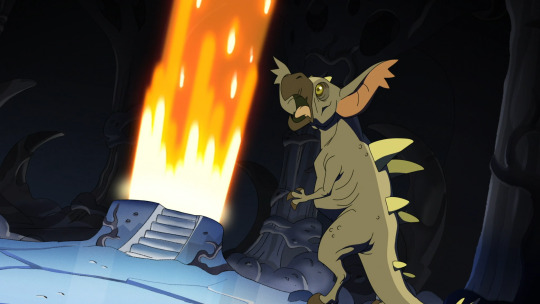
As a side-note, we also see from Philip’s later glyphs that, in my interpretation, a secondary meaning can also be used as a focus/anchor (Fire on bottom-left for water fountain (Motion) and Plant on bottom-left for monster arm (Evolve/Change)). I’ll get to them later, but merged elements can also be used as the central point. A Null glyph can also be a central glyph, and doesn’t have to be drawn since context excludes any other option of being the centre instead (f.2).
I also think that, in general, Ice and Plant glyphs will enact a spell more gradually, while Light and Fire glyphs will do so quickly/almost instantaneously. Also, Plant and Fire glyphs make a spell grow over time, while Ice and Light glyphs don’t. But that’s just an idle thought.
To make actual sentences with other words, however, we also need to add further descriptors on what this central/anchored word should do. This is where the glyph circuits come in, forming concentric circles centred on the central glyph. All glyphs and their corresponding meanings on this circle are direct descriptors for the central glyph that apply at the same time (e.1). Let’s call these descriptor circuits.
One quick note, with this setup we can run into the problem of needing two different glyphs to be at the same location, causing an overlap (f.3). To avoid this, let’s add the ability to draw a circle tangent to this point, keep one of the two glyphs on the tangent point as a ‘tangent glyph’, and move the other to somewhere else on the circle. See illustration below. Let’s call it a spacer circle/circuit. In the case of three or even all four glyphs overlapping, all can go somewhere on the circle. The position of the glyphs on this circuit doesn’t matter, but at least one should be off-grid, i.e. not centred on cardinals or diagonals (to clear up distinction issues later).

We also see from the teleport glyph that you can have multiple descriptor circuits all concentrically surrounding the central glyph. In the case of a second circuit, I’ll take it as meaning that the glyph combination it encircles can already count as its own nested spell, and this second circuit applies to the entirety of the enclosed spell. The reading order for this would thus be from centre to edge. I also think each added layer of circuit to the central focus produces a spell that can technically function on its own, even if it might be too unwieldy or useless or have dangerous side-effects without further description.
But what if there’s a nested spell that’s separate from the one already built up from the central glyph, an entire spell that needs to be applied to the main spell along with other descriptors in the same circuit? In that case we could attach a different glyph combo, like a nested sub descriptor circuit (subcircuit for short), onto one or more of the main descriptor circuits (if more exist). This subcircuit has the same rules as the main circuit, except it may not have a central glyph if it matches that of the main one, and might only work on other spells. In short, it's like a subroutine (if we’re pulling in coding language).
To also distinguish it from the previous spacer circle, let’s specify that a subcircuit has a glyph on an intersection point with other circuits, an ‘intersecting glyph’, rather than on a tangent point as a ‘tangent glyph’. We can also use this by saying that the glyphs on a subcircuit that occupy an intersection with another circle indicate that the subcircuit applies to those other circles. In order to line things up, you’d have to play with the size and location of the circle in relation to the main circle. Though you’d also have to keep in mind that glyphs on an intersection could have multiple meanings with their different placements for each of the different circles, which may be unwanted. To combat that, let’s add a rule that a glyph on an intersection always applies its meaning only to the more nested or otherwise smallest circle of the intersection, unless specified otherwise (we’ll get back to that later), and if there’s no other way you could use a Null glyph to add a connection (a.2).
With the main descriptor circuits, subcircuits, and spacer circuits, there’s only one more that is needed to make sure every bit of the vocabulary can be applied.
To add the merged/secondary elements from before, let’s add a merger circuit, which has the two or three elements you want to merge to form the secondary element, and let’s have them all equally spaced, reading the order of elements from left-most and moving clockwise.
To make sure this can be distinct from the sub- and spacer circuits, let’s say that, unlike the prior two, it has both a glyph only on an intersection point (or multiple) and at least one of the glyphs on a merger circuit is off-grid. In the case of 2-mergers that’d have to be both, and for 3-mergers you’re guaranteed to have at least one off-grid anyway (The joys of matching up a circle divided into equal threes with a circle divided into equal eighths). So now a subcircuit only has an intersecting glyph (or more) and all glyphs on the grid, spacer circuits only have a tangent glyph (or more) and at least one glyph off-grid, and merger circuits only have an intersecting glyph (or more) and at least one glyph off-grid.
This actually leaves open another useful combination, a circuit with only a tangent glyph (or more) and all glyphs on-grid. Let’s call this last combination a specification circuit, which adds extra descriptors onto only the glyph at the tangent point. It’s not a spell on its own, but adds adjectives and adverbs to the noun or verb it’s tangent to the other circuit with.
As a quick overview for some visualisation, here’s a glyph spell I put together, containing each of the circuits I’ve mentioned above, and with glyphs randomly thrown in. Though this was just set up for explanation purposes, let’s also try an attempt at reading said glyph with the rules I’ve set up and see if anything reasonable pops up (and keep your look-up diagrams with you. Can’t believe I made actual look-up diagrams).

Surprisingly, though maybe it’s just me spotting patterns in nothing, this isn’t complete gibberish, and I’d interpret this spell as being something that connects memories that are in danger of being absorbed by someone else to light balls, but also using it to order them and move them around, as long as the subject is aware of it happening. Sounds a bit like a mindscape defence against mind-reading. So yeah, that’s the basics out of the way.
Let’s see how this works out with the basic glyph combos in the show.
Invisibility glyph:

Lightened (centre, adjective) coloured (top-left, adjective) transparency (bottom-right, noun) order (bottom-left, noun) → Subject becomes lightened by coloured transparency through order → Invisibility through camouflage. Side-note, the bottom-left glyph can be absent and the glyph still works, as seen in its first instance. But I think the ‘order’ allows for multiple to be camouflaged by the one glyph.
Safety hover glyph:

Light (centre, noun) stillness (top-right, noun) movement (bottom-left, noun) → Use light on movement to make stillness → Stop subject’s movement instantly.
Snow/Command glyph (copyright, Lilith):

Null (centre, not drawn, surrounding circle isn’t a merger circuit (repeats of Ice) so isn’t acting as central glyph, meaning the empty space is an implied Null glyph) power (top, adjective) weakness (bottom, noun) preserved (left, adjective) removed (right, adjective) → The external object touching the centre is removed, this process is powered through weakness, yet the object is preserved → Break down this object through sheer power but keep the debris (In the case of the ice blob, break it down and powder it into snow)
So that turned out pretty well (Though I did already say I ordered the diagram with secondary glyph meanings to at least make sense of the basic glyphs).
Let’s go one final step further and see what we can use from what Philip eventually used in his glyphs.
Shortcuts and Miscellaneous Stuff
Let’s add one more concept to this entire system before that though.
h) Condense and simplify glyphs as much as possible.
Obviously, for usability it’s always best to find a way to get the same spell/effect with a glyph that’s easier to draw. And since this system is like a language, it’s like saying there are multiple ways of saying the same thing, with some faster to say than others.
But more than that, it’s also like shortening actual sentences with contractions, abbreviations, and finding that one specific obscure word in the Thesaurus that you previously had to use several words for to describe. For example, if you have multiple non-concentric circuits you could attempt orientating them to have multiple instances of the same glyphs overlap and work from there.
Another thing that was mentioned a while back was how glyphs on intersections only apply to the smaller circuit, unless specified. Well, let’s say this can be specified by drawing a straight line from the intersection glyph to the central glyph of the bigger circle, indicating it contributes simultaneously to both circles with two separate meanings.
This way of using straight lines to show a glyph is pulling double- or triple-duty can also be applied to drawing a line between two glyphs on the same circuit. This would make use of the previously discarded concept for how glyph meanings are ‘diff 4 placement’, indicating that the connected glyphs also have additional meanings based on their relative placement to one another.
For example, let’s take Philip’s petrification glyph.
Petrification glyph:

Iced (centre, adjective) removed (right, adjective) [Change (relative bottom-left, noun)] preserved (left, adjective) organism (bottom, noun) [Stilled (relative top-right, adjective) inorganic (relative top, adjective)] → Organism is removed but preserved, by having changed the stilled organism into something inorganic.
That already works amazingly on its own, though there’s also this funky plant glyph that’s unconnected to a circle but still connected to other glyphs by straight lines.
Something that hasn’t been tackled yet is how to actually use the primary meaning of the basic glyphs outside of being the central focus, because there’s no other place in the current rules for the basic glyphs to apply their elemental meaning on anything. So let’s make it so that a basic glyph that’s disconnected from a circle still has primary meaning, and is applied to other glyphs with straight lines. In this case that would add that iced life is preserved.
…This obviously doesn’t work too well since in canon the petrification is permanent and kills the petrified person, but I’ll gladly hop onto the convenient lifeboat that is the context of this glyph being incomplete. I’d say Philip was originally experimenting with a way of turning someone into stone as a defensive spell, but a) didn’t know how to express stone yet, and b) didn’t want it to be permanent, since that would be pretty iffy unless he already has all the power over the Boiling Isles and nobody attempting to question him for killing people. So this original glyph just turned the subject ‘inorganic’, which is apparently just some weak dust, so the preserving of life to make it reversible is pretty useless here anyway. Clearly not complete yet. In the completed, proper petrification glyph, the small Plant glyph with the two connections would be gone to make it irreversible, and a merger circle of Fire and Plant (Earth) with the two glyphs intersecting with another, appropriately sized merger circle with Ice as the third glyph (Hard), bringing a total circuit for (Hard Earth = Stone).
Either way, let’s add elemental modification to the toolkit.
Let’s go to the other three of Philip’s WIP glyphs and try to make sense of them, plus whatever extra features were added. First up, water fountain.
Water fountain glyph:

Sever (centre (top-left), verb (there’s no real noun for ‘sever’, and no double border so all that’s left is verb)) tangible (top-left, adjective) still (top-right, adjective) transparent (bottom-right, adjective). We also have some funky spiral lines connecting the three to the central point. My current translation would be ‘sever something here that’s tangible, still, and transparent’. My guess is that my boi Phil was trying to make a glyph that could isolate groundwater and get it out of the ground, probably for survival purposes since groundwater would be drinkable compared to the Boiling Sea and Rain (Luz assumes the glyph is meant to make a water fountain, but that’s just what she sees the glyph doing, not what its intended use is). Obviously he didn’t know how to properly express ‘groundwater’ at this point, or thought it was too bulky to write down that way, and went with a vague description of ‘tangible but transparent and still (not moving in the ground)’ instead. I think the spiralling lines here are supposed to provide a direction for the motion (there’s no motion glyph in here, i.e. Fire bottom-left, but severing water from the ground would probably push it up and give it some motion regardless, so the lines help direct it). It would make sense, since just bringing water straight up would make it fall back down on the ground, so you need a little trajectory to have it land in a gathering bowl next to the glyph. That said, let’s add motion lines.
Next up, monster arm:

The new feature here is a partial circle segment capped off by two fire glyphs. The first thing that comes to mind for me is that this is supposed to be an abbreviation for when you have to draw the same glyph on neighbouring locations of the circuit. So instead you only draw the correct glyph at the ends of the sequence and let the line imply the rest of the meanings involved. In this case: Evolution/Change (centre (bottom-left), noun) Protect Decay Weak Motion Hurt Sever Deception (right-to-top (clockwise), nouns), and on a second circuit ring, Evolution (bottom-left, noun). My current thoughts are that the ground or whatever sits at the central circle undergoes a change into something that can protect, move, hurt, sever, and deceive. And whatever that thing becomes is then told to continue evolving/changing/adapting.
What I think makes this glyph a failed WIP is that, though the segment already excludes Chaos (top-right), which would be pretty detrimental for a construct you want to order around, it does still include Weak and Decay (bottom and bottom-right), which makes the monster arm physically weak, prone to damage and slowly breaking down over time, as demonstrated in the episode. But Philip didn’t want to let go of using the segment to draw only two Fire glyphs instead of five either, as further breaking up the segment would isolate the Fire glyph on the right, which would separate the glyph from the system and turn it into a separate one that happens to occupy the same space, and a full circuit would require drawing five glyphs too). I think a good solution that Philip probably used in the completed version would be to use the Null glyph to further exclude the meanings that aren’t desired while keeping the full line segment intact.
Definitely useful to simplify the drawing process, so let’s add sequence segments as well.
Last of the WIP glyphs: the tornado glyph, which is the only one that actually works decently, on a small scale anyway, and saved for last for good reason.

We now have some sort of combination of circle segments positioned in layers, and direct line connections with both disconnected and connected element glyphs, as well as straight radial lines coming from the central glyph.
Since these Fire glyphs are on actual circular segments, let’s begin simply with the normal secondary meanings.
Tornado glyph: Icy (centre, adjective) Emitted (bottom-left, adjective) Sever (top-left, verb) Protection (right, noun) Weakness (bottom, noun).
Alright, so it took a while, but if I really want to make sense of this I’ll have to budge some parts of the word type indicators in the right direction. In this case, the bottom glyph will be changed to the adjective version, and the right glyph turned into its verb version.
To start with, as a circle segment, the line trajectory is only associated with Fire, and with the radial line segments in the bottom-left and bottom-right we’ll add those meanings as well. And the connection to the bottom-left Light glyph means something as well. So we now have Emitted (Light, bottom-left) Movement (Fire, bottom-left) Weak (Fire, bottom) Decays (Fire, bottom-right), so ‘an emitted movement that’s weak and decays’. It’s also connected to the circle segment one layer deeper, which has Protect (Fire, right) Decay (Fire, bottom-right). So we have ‘an emitted movement that’s weak and decays, but is protected from decay’. Since the line segment connects the outer circuit line (with the Light glyph) to the central glyph, and the outer glyphs apply to the inner ones, we also add some directionality. So now it becomes ‘an emitted, weak movement that decays as it moves inwards, but is protected from slowing down in total’. That’s probably just me budging everything, but that sounds like how the movement within a vortex of air behaves.
Lastly, the top circle segment has Sever (Fire, top-left) and Chaos (Fire, top-right), and has no connection between the outside circuit and the central glyph. So I’d say ‘sever chaos’ i.e. counteract the chaotic movement of the already existing air, and thus making it organised when it begins moving. Altogether, this glyph describes an ‘emitted, uniform motion that decays as it goes inwards but remains stable overall’. It might’ve been a bit wonky to get here, but none of the rules I’ve made have been contradicted yet and it actually got a decently accurate reading out of it.
Conclusion (plus an attempt to make a glyph from scratch for an existing spell)
So yeah, that’s literally all there is, and I think I got a cohesive system together that fits all the concepts I listed at the start, even if it’s certainly got a lot of cogs, but that’s to be expected when your system is described as a language.
Technically I could also cover Philip’s Teleportation glyph or the unlocking glyph Belos used to enter the Grimwalker area in the Skull, but that’s a) too much effort and probably doesn’t match up with my meanings for the former, but it can be left up as an exercise to the reader. And b) the additional rules the latter glyph could imply would probably be far too complex and unnecessary for this post, or for making glyphs altogether. We gotta keep in mind that that glyph is from someone who’s been experimenting and drawing for 400 years, so the previous simplifications/tricks I covered in the last section would be far more amplified and complex.
Either way, with that all finished up, let’s use it to build a glyph from scratch that mimics a complex spell we see used in canon but doesn’t have a glyph counterpart.
For this, I’ll use the ‘quick-step’ spell we see Eda and Lilith use, where they turn into flame and quickly move elsewhere, reappearing at the end. Hunter does something similar with Flapjack, but there it’s done with light.
So, the central component of this entire spell will be moving. And the descriptor circuit for that movement will be something like ‘[move] a person quickly along a path’. ‘Quickly’ here can be made with a merger circuit. Then, if I want to recreate the spell accurately, the path needs to be specified to be somewhat short, so you can’t just use it to teleport somewhere far away. This can easily be done by specifying that it has to be visible for the caster before they cast it, using a specification circuit.
The next component will be the turning the person into fire. This sounds like a spell on its own, even if it’s pretty deadly, so it’ll be a nested spell that links to the main circuit through a subcircuit. The subcircuit will then be something like ‘change person into fire’. Since this spell is still very much deadly on its own, it’ll also need its own specifier saying that the person should be preserved during the change, for protection.
Lastly, it still needs a way to reverse this change from fire back to person once the spell has reached the end of the connection. In this case, ‘Reverse’ and ‘Ending’ can both be made from merger circuits.
Now we just need to add all those circuits together, making sure each type of circle has the right border glyphs and glyph positioning (tangent or intersecting, on-grid or off-grid), and lastly the condition of ‘reverse transformation spell at end of trajectory’ needs to be properly linked up.
And with that we get the final Quick-Step glyph below.
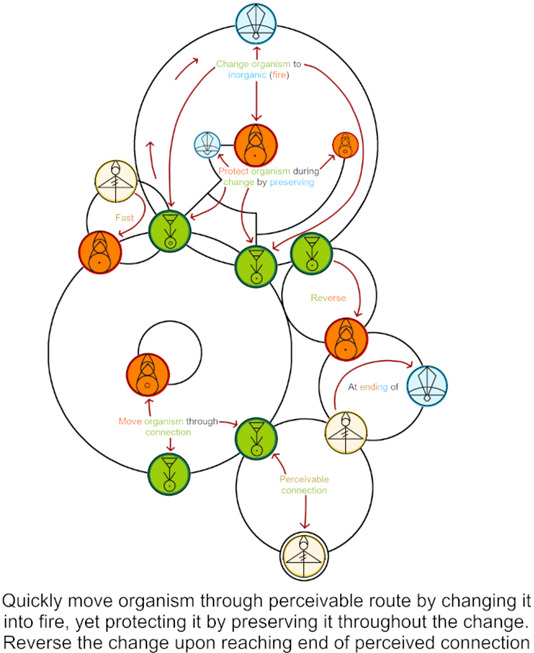
Some additional notes. The top circuit didn’t technically have to go at the top-right, but it did need to intersect with the main circuit through one of its glyphs. The only other place where it wouldn’t have overlapped with the main circuit’s glyphs would’ve been in the top-left, with the merger circuit for ‘Fast/Quick’ needing to rotate down on the main circuit a bit to accommodate. But in that case the series of connected circuits for the ‘reverse at end of trajectory’ would’ve been impossible to draw compactly. Either they’d go straight over the main circuit, or going around the circuit would require giant circles.
And then there’s also the inside line segments of the subcircuit. I haven’t established the rules for how those would work, and I’m playing it a bit loose there, but basically the places where the circles jump down in layer (shorter radius) is where the glyphs on the outside ring slot in. If the segment had jumped down a layer where a glyph from the outside hadn’t been connected into it, then it would’ve been the corresponding definition for the Fire glyph at the start of the circuit. The reading order here is also from the Fire glyph towards the centre. And lastly, the outside circuit of the spell ‘organism change inorganic’ does need disambiguation, since it could also be read as ‘inorganic change organism’. The direction of how the inside circuit approaches the middle helps disambiguate that, giving it a defined reading order, which is then read in reverse once the ‘Reverse’ circuit comes into play.
And…wow, I think that’s all. I’ve spent an entire day typing this out (plus way too many days of experimenting with things and coming up with some rules), and few people will probably see this, but damn that was satisfying to write out.
For those of you who read all the way to the end, or God forbid actually took the time to take it all in, thank you very much!
…I’m going to bed.
#the owl house#owl house#glyphs#glyph magic#theory#analysis#discussion#toh#owl house theory#glyph combos
76 notes
·
View notes
Text
INTERESTING
My deep dive into the glyphs.
Obligatory spoiler warning
The teleportation glyph in Elsewhere and Elsewhen got me thinking about glyph mechanics, and I think I might have a basic understanding. Note that this is an incomplete theory, and feel free to expand on it.
By themselves:
Light glyphs create light.
Ice glyphs make various sizes and shapes of ice.
Fire glyphs create a small explosion or ball of fire.
Plant glyphs create various types of plants.
If you look at the glyphs when added into combinations, they have additional functions, which I am generally sorting out as:
Light glyphs provide specific focus.
Ice glyphs affect vision.
Fire glyphs provide power/general focus.
Plant glyphs provide transportation.
Assuming these facts are true, let’s look at the glyph combinations we’ve seen.
The invisibility glyph: In Follies at the Coven Day Parade, it’s revealed this is made with 2 ice glyphs and 2 light glyphs. However, the glyph had previously been shown to only have three glyphs involved.
First, it’s worth mentioning that the glyph combo is reminiscent of how light refracts through glass/water/ice to create distorted vision.
If we assume the previously mentioned facts are correct, then the ice combined with the center light glyph causes the invisibility, and an extra light glyph is added for every person, to focus the spell on multiple targets.
The steam glyph: This is much simpler, being only an ice glyph and a fire glyph, plus an ingredient in the to create an extra effect, if so desired.
The obvious is that ice and fire make steam.
The previously mentioned mechanics state that the ice is the reason for blocking vision, and the fire adds power to it and puts it on the general area rather than an individual.
Snow glyph: Done with a mix of light, ice, and fire.
Ice sculpture: 2 ice glyphs.
The above 2 are examples that would imply the uses for ice and light are switched, with light affecting vision and ice helping focus.
I’m going to take a guess that plant glyphs can be used in the same way as regular spells, and could with enough focus be used for transportation.
That being said, let’s look at the teleportation glyph with the same logic we’ve been using.
Teleportation: A combination of fire, ice, and plant glyphs.
If we follow the previous rules, the fire provides a general focus on all targets involved. The ice glyphs mask the people being teleported as they move, and the plant glyphs move them to the desired location.
I’m aware that it’s an incomplete idea, which is why I’m bringing it here. But this is as far as I’ve gotten.
What do you think?
#the owl house#glyphs#magic#glyph magic#theory#headcanon#elsewhere and elsewhen#follies at the coven day parade#glyph combos#toh meta#readmore +#writing ideas
48 notes
·
View notes
Text
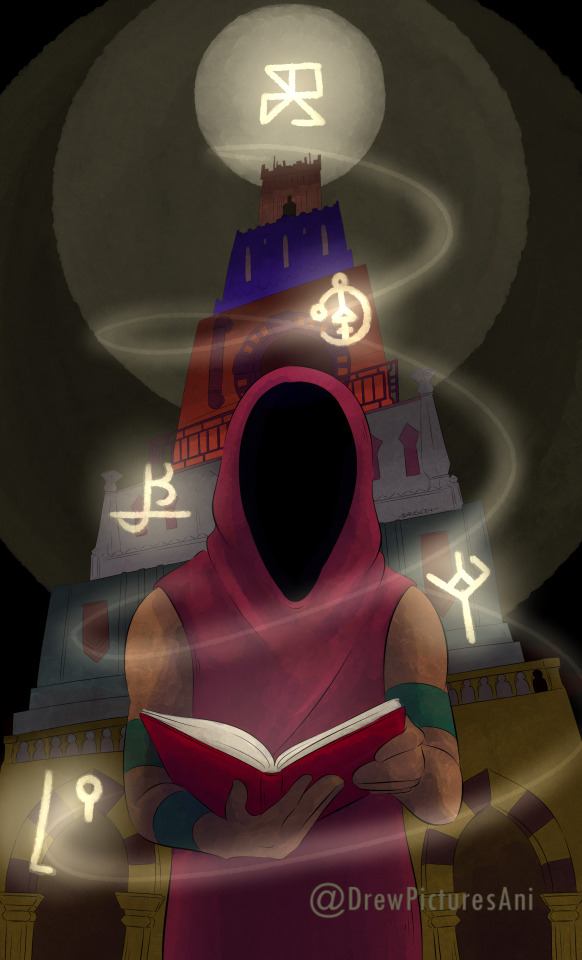
The Traveller
So Chants of Sennaar is a good game-
#chants of sennaar#cos traveller#traveller sennaar#fanart#chants of sennaar spoilers#sennaar#art#character portrait#support small artists#tower of babel#hiiii these are custom glyphs based on how I think each floor might come to refer to the traveller#devotees is a combo of [person] and [up/great] as the traveller helped them to open the doors and ascend#warriors is [person] and [go/pass] as the traveller filtered through their ranks without trace#bards is [freedom] with their lil [person] signifier loop on the bottom as the traveller brought both the serfs and the upperclass bards#their own kinds of freedom#the alchemists is a mix of [specific person] and [open] as the traveller opened their fairy door#and the anchorites#extra spoiler warning just in case#the anchorites is a combination of [key] and [talk] - because they made the traveller to unlock the closed off communication between#the peoples of the tower#PLUS it looks like the ...#what are we calling the god/duty/beauty/transformation/exile glyph yall#the connection glyph?#thatll do
368 notes
·
View notes
Text


A while back, I made a post explaining my thoughts on the Teleportation Glyph Combo. I began thinking about it more and I think I might’ve realized one reason why the only satellite circle that is attached to all 3 circles that wrap around the Fire Glyph in the center also has a Fire Glyph in its own center with 3 Plant Glyphs and 1 Ice Glyph around it and also what the other 2 satellite circles are for. I think that one of the reasons why it’s the only satellite circle that’s connected to all 3 circles that wrap around the Fire Glyph in the center of the Teleportation Glyph Combo is because it directly represents the person or thing that is being teleported. The Fire Glyph in its center probably represents the energy in said person or thing since, as real life science established, all physical matter has energy like potential energy and kinetic energy for example and fire emits energy in the form of heat and I think that the 3 Plant Glyphs and the 1 Ice Glyph probably alters the power of the Fire Glyph to the point that it allows it to accommodate the physical aspects of the person’s or thing’s matter since plants and ice are both forms of physical matter themselves. Also, I think that the 3 Plant Glyphs, with some help from the 1 Ice Glyph, helps the energy from the Fire Glyph accommodate the matter’s distinct properties since different plants have different properties given that trees are partly made of wood while flowers aren’t just like how different matter has different properties given that water is made of a liquid while metal is made of a solid and I think that the 1 Ice Glyph helps the Plant Glyphs accommodate the matter’s properties by helping the energy from the Fire Glyph accommodate the physical matter’s shape since ice can have a wide variety of different shapes depending on what is frozen like how a frozen football can be shaped like a football and how a frozen soda can can be shaped like a soda can just like how physical matter can have a wide variety of different shapes depending on what shape the physical matter is. As a side note, I think that if a Glyph Combo with a Fire Glyph in the center and 3 Plant Glyphs and 1 Ice Glyph around it were used on a person, it would probably double their strength, speed, stamina, etc. After all, given everything I pointed out, a Glyph Combo with a Fire Glyph in the center and 3 Plant Glyphs and 1 Ice Glyph around it would represent the person it’s used on which would surely mean it would represent their strength, speed and stamina too. So, a Glyph Combo with 1 Fire Glyph in the center and 3 Plant Glyphs and 1 Ice Glyph around it would basically be an Enhancement Glyph Combo.
As for the satellite circle with the 1 small Plant Glyph and 1 small Fire Glyph in the center with 3 Glyphs consisting of 1 large Fire Glyph, 1 medium Plant Glyph and 1 medium Ice Glyph around them, I think it has to do with the transference aspect of the Teleportation Glyph Combo since I believe what it does on its own is energy transference. I think that, at least while working in conjunction with the other 3 Glyphs, the small Fire Glyph and the small Plant Glyph represent the energy which resides within a person or thing with the Fire Glyph representing the energy aspect since fire emits energy in the form of heat and the Plant Glyph representing the person/thing aspect since people and things contain potential energy and kinetic energy like how plants contain energy that’s absorbed from the sun and the large Fire Glyph, the medium Plant Glyph and the medium Ice Glyph helps the 2 small Glyphs represent the energy that resides within a person or thing and also represent the transfer to the other person or thing. I think that the large Fire Glyph is the biggest of the 3 Glyphs because it helps the 2 small Glyphs represent the energy by allowing it to grab the energy within the first person or thing thus allowing the small Fire Glyph and the small Plant Glyph interact with said energy since fire emits energy. The large Plant Glyph is probably what starts moving the energy from the first person or thing to the second person or thing since tree branches can lead to and reach the tree next to it like how the energy from the first person or thing would be being led to the second person or thing. And the Plant Glyph is probably what makes it so that the energy from the first person or thing can accommodate some of the different properties of the second person or thing. After all, as I pointed out earlier, different plants can have different properties just like how different people or things can have different properties. As for the Ice Glyph, it’s probably the aspect of the Glyph combo that helps the Plant Glyph make it so that the second person’s or thing’s physical matter can contain the first person’s or thing’s energy by helping the energy from the first person’s or thing’s energy accommodate the second person’s or thing’s physical shape since ice can take on different shapes depending on what’s being frozen. An Energy Transference Glyph Combo would probably be a part of the Teleportation Glyph Combo since both Energy Transference and Teleportation involve transferring someone or something from Point A to Point B. As for the satellite circle with 1 Fire Glyph on one side and 1 Plant Glyph on the other side, I think that it helps with the Teleportation Glyph Combo’s disassembly process at Point A and its reassembly process at Point B. After all, according to some sci-fi, teleportation is about disassembling something at Point A and reassembling it at Point B. And fire is all about burning things down thus disassembling them while plants are about regrowing thus reassembling themselves. And I think that what a Glyph combo with a Fire Glyph on one side and a Plant Glyph would do on its own, I think that it would break things down and then safely reassemble them. The Fire Glyph would break the thing the Glyph Combo is used on down and then the Plant Glyph would reassemble it. So, it would basically be a Disassembly And Reassembly Glyph Combo.
I think I’ll also take a look at the second and third circles that wrap around the Fire Glyph in the center of the Teleportation Glyph Combo. The biggest Glyph in the second circle that wraps around the Fire Glyph in the center is a Fire Glyph. I think that might have to do with the fact that, as @cartoonsofthecosmos pointed out in their The Anatomy Of Philip’s Teleportation Glyph post, Fire Glyphs seem to be the most important Glyph in the Teleportation Glyph Combo. I think one of the reasons for that is because, like how whatever is teleported is, at least for a brief moment, disassembled at Point A but has yet to emerge at Point B means it’s essentially nowhere in the cosmos, being burned by a fire means that the specific thing that has been burned is also nowhere to be found in the cosmos since it has been destroyed. So, this part of the Teleportation Glyph Combo probably corresponds with the aspect of teleportation that means being essentially nowhere in the cosmos for a brief moment. As for what the Glyph combo of the second circle would do on its own, I think that it would dematerialize whatever or whoever it’s used on which would make it a Dematerialization Glyph Combo. The Fire Glyph is the biggest there probably because dematerializing something is pretty much the same as destroying it and destroying things is what fire is about. And the next Glyph counter-clockwise of the big Fire Glyph is a Plant Glyph and the next Glyph clockwise of the big Fire Glyph is an Ice Glyph. As I pointed out earlier, Plant Glyphs and Ice Glyphs can represent the person’s or thing’s properties and shape respectively. And I think those are what the Plant Glyph and the Ice Glyph represent here. Also, I think that the Plant Glyph just counter-clockwise of the big Fire Glyph is smaller than the Ice Glyph just clockwise of the big Fire Glyph is because the Fire Glyph needed to overwhelm it more since the inner properties of a person or thing are a bit more fundamental than the person’s or thing’s shape and thus the properties of the person or thing take priority. And the rest of the Fire Glyphs, Plant Glyphs and Ice Glyphs probably fuel the destructive effect to the point that the physical matter is fully dematerialized since, out of the rest of them, the Fire Glyphs go first which would probably help with the destructive effect over the aspects represented by the Plant Glyphs and Ice Glyphs that come after the Fire Glyphs.
As for the third circle that wraps around the Fire Glyph in the center, the biggest Glyph there is a Plant Glyph. As I pointed out in my previous post about the Teleportation Glyph Combo, underground roots would be able to survive a forest fire which probably means that the Plant Glyphs would be able to help the person’s or thing’s essence stay preserved despite said person or thing being disassembled at Point A. And I think the person’s or thing’s essence being preserved would help them survive the travel from Point A to Point B. As for what the Glyph combo of the third circle would do on its own, I think that it would render whatever or whoever it’s used on indestructible. After all, both being preserved and being indestructible are all about saving something from being destroyed. Also, counter-clockwise of the big Plant Glyph is a small Fire Glyph followed by a large Fire Glyph. I think that’s meant to represent the person or thing adapting to what would otherwise destroy them by being exposed to small amounts of it little by little before then being ready to handle the big amount. And clockwise of the big Plant Glyph is a Fire Glyph followed by a Plant Glyph and then another Fire Glyph followed by another Plant Glyph. I think that’s also meant to help the person or thing adapt to what would otherwise destroy them since they probably represent the plants that are the person or thing constantly growing back over and over despite constantly being burned down by the fire that is the destructive force that would otherwise destroy the person or thing. And I think that the last Plant Glyph being bigger than the Fire Glyph just before it is meant to represent the person or thing prevailing over the destructive force in the end. Also, the Ice Glyph in the third circle probably makes sure that the person or thing stays intact and unharmed in the process since ice is basically water solidified and being solidified is the opposite of being melted and, by extension, damaged or destroyed. I think that this makes it so that the person or thing won’t go through any damage that the Fire Glyphs would otherwise cause.
Now, I’m gonna be going over the Fire Glyph in the center of the Teleportation Glyph Combo. A camp fire’s shape is like a surface with spikes. I think that one of the fire’s spikes represents Point A while one of the fire’s other spikes represents Point B. And the fire underneath the spikes represents the space between Point A to Point B. So, the Fire Glyph in the center of the Teleportation Glyph Combo probably represents the space between Point A and Point B. Also, according to Thich Nhat Hanh’s philosophies, everything is interconnected and interwoven. That might also mean that the person’s or thing’s energy is connected to the wider cosmos’s energy which would make sense since everything and everyone were created from the cosmos which would mean that their energy is part of the wider cosmos’s energy, the Fire Glyph in the center probably also helps represent the wider cosmos’s energy that the person or thing that is essentially connected to. After all, the satellite Glyph combo from earlier with the Fire Glyph in its center and the 3 Plant Glyphs and the 1 Ice Glyph around it branches off from the Fire Glyph in the center of the Teleportation Glyph Combo itself and that satellite circle Glyph combo on its own already represents the energy of the person or thing that is being teleported. So, with the help of the Fire Glyph in the center of the Teleportation Glyph Combo, the satellite circle Glyph combo with the Fire Glyph in its center and the 3 Plant Glyphs and the 1 Ice Glyph around it would probably not only represent the person or thing but also the wider cosmos’s energy that the person’s or thing’s own energy is connected to.
Now that I’ve gone over all the different components of the Teleportation Glyph Combo, I’m gonna try to explain how they work together. The second circle’s Glyph combo which dematerializes and thus destroys things intersects 2 of the Plant Glyphs that are a part of the satellite circle that represents the person or thing that is being teleported. And since it intersects the part of said satellite circle that runs in between the Fire Glyph in the center of the satellite circle which represents the person’s or thing’s energy and the Fire Glyph in the center of the Teleportation Glyph Combo which represents the wider cosmos’s energy, I think that’s meant to symbolize the second circle’s Glyph combo breaking down and thus destroying the proverbial barrier that separates the person’s or thing’s energy and from the rest of the wider cosmos’s energy. This would allow the rest of the wider cosmos’s power to flow directly within the person or thing. However, the overwhelming power of the wider cosmos’s energy would probably be too much and destroy the person or thing in the process. But since the satellite circle that represents the person or thing directly connects the second circle to the third circle, I think that this is where the third circle’s Glyph combo which preserves things comes in.
Since it directly intersects the Fire Glyph in the center of the satellite circle that represents the energy of the person or thing, it would more or less preserve the person’s or thing’s energy but, given that the third circle’s Glyph Combo is further away from the center of the Teleportation Glyph Combo than the second circle and thus would have a somewhat weaker effect, the rest of the wider cosmos’s power would probably still overwhelm the person or thing to the point that, while it won’t destroy them, it will still convert the person or thing into the wider cosmos’s energy. But since the person’s or thing’s energy would still be more or less preserved, the person’s or thing’s inner essence would probably still survive. Also, this would probably cause the person or thing to disappear from the corporeal universe and, by extension, Point A since, given that the person or thing pretty much got absorbed by the wider cosmos’s energy, the person or thing is nowhere in the universe since they’re not in any specific spot in it but they’re also still around since their inner essence is still intact. So, the person or thing that is being teleported got reduced to nothing but their essence but, thanks to the third circle’s Glyph combo’s power to preserve things, the person or thing is still surviving as their essence.
And since the satellite circle that represents the person or thing that is being teleported has a Plant Glyph and an Ice Glyph that haven’t been intersected and are further out than the second circle as well as the third circle, their power will probably be unaffected by the person or thing being converted into the wider cosmos’s energy. And they’ll probably help convert the person’s or thing’s essence which is now the person’s or thing’s energy that got converted into the wider cosmos’s energy into something that at least more resembles the person’s or thing’s regular energy since that Plant Glyph and Ice Glyph are a part of the satellite circle Glyph combo that represents the person or thing. After all, plants focus only on solar energy when it comes to absorbing energy which means that the Plant Glyph will probably be able to focus only on the person’s or thing’s essence thus making sure that the Ice Glyph’s power doesn’t effect the rest of the wider cosmos’s energy too. As for the Ice Glyph, it will probably “solidify” that energy into something that’s at least a bit more similar to the person’s or thing’s regular energy since the ice that is the Ice Glyph’s power could freeze “a certain bit of water” that is the person’s or thing’s energy into a block of ice that gets to keep its shape even while stuck in the depths of the ocean that is the wider cosmos’s energy. This also corresponds with how this Ice Glyph also, as I pointed out earlier, represents the aspect of the person’s or thing’s energy that accommodates the person’s or thing’s shape. Also, I think that the satellite circle that represents the person or thing is the first of the satellite circle Glyph Combos here to take effect because, unlike the other 2 satellite circles which only directly connect to the second and third circles that wrap around the Fire Glyph in the center of the Teleportation Glyph Combo, this satellite circle also directly connects to the first circle that wraps around said Fire Glyph. So, this satellite circle goes first since it’s directly connected to a more fundamental part of the Teleportation Glyph Combo. That even includes its Plant Glyph and Ice Glyph outside the third circle since those 2 Glyphs are still parts of the satellite circle which is connected to the first circle and thus those 2 Glyphs technically share the satellite circle’s connection to the first circle around the Fire Glyph in the center of the Teleportation Glyph Combo. However, in the case of the other 2 satellite circle Glyph combos, they’re pretty much on equal footing in terms of being fundamental for the Teleportation Glyph since they each are directly connected to both the second and third circles. So, both of these satellite circles’ inner halves (the parts of them that don’t go further out than the third circle) come before either of their outer halves. With that out of the way, the Fire Glyph on the satellite circle Glyph combo with said Fire Glyph on the inner end and the Plant Glyoh on the outer end has already done its job with the person’s or thing’s disassembly at Point A given that its Fire Glyph was a part of the first circle’s Glyph combo which also represents the person’s or thing’s disassembly at Point A. So, next comes the first half of the satellite circle Glyph combo which represents the transference aspect of the teleportation. So, this satellite circle would probably use its 1 small Fire Glyph, 1 small Plant and 1 large to grab hold of the person’s or thing’s energy since, as I pointed out earlier, those 3 Glyphs would probably represent the energy of a person or thing. Then, the satellite circle Glyph combo uses its medium Plant Glyph to help the person or thing reach Point B and form the person’s or thing’s energy there in the corporeal plane since, as I also pointed out earlier, a tree branch can allow the tree that is the person’s or thing’s energy to reach and thus form in the thing that the energy is being transferred to which, in this case, is Point B.
Now for the Plant Glyph on the outer half of the Glyph combo with the 1 Fire Glyph and the 1 Plant Glyph. I think that this Plant Glyph might use the newly reformed person’s or thing’s energy at Point B as a seed from which the person’s or thing’s physical matter to grow from. Lastly comes the Ice Glyph on the outer half of the Glyph combo with the 1 small Fire Glyph and 1 small Plant Glyph in its center with 1 large Fire Glyph, 1 medium Plant Glyph and 1 medium Ice Glyph around them. This Ice Glyph might simply shape the physical matter forming because of that Plant Glyph on the satellite circle Glyph combo with the 1 Fire Glyph and the 1 Plant Glyph into the shape of the person or thing since ice can take on different shapes. With that, the teleportation process is finished.
Well, that’s all for this post.
See you all next time.
7 notes
·
View notes
Text
god glyph of repulsion is just so fun. it makes me feel like a mage version of bugs bunny. people run at me with murder in their eyes and then -- boi-oi-oing!!! sorry. you're in a comedy now. such is my power
#'tunnel of illusions: you paint a tunnel on a cliff wall and wait for a sucker to come by'#dragon age#dragon age origins#cone of cold is my oldest and truest da:o friend but glyph of repulsion doesn't have friendly fire which is a plus#(the paralysis + repulsion combo does tho which sucks! sorry alistair didn't mean for you to get caught up in that look I'll heal you)#I just feel like it's very in character for sophia to try to cast a spell of 'nothing in this world fUCKING TOUCH ME without my say-so'
9 notes
·
View notes
Text
yesss!!! 👀👀
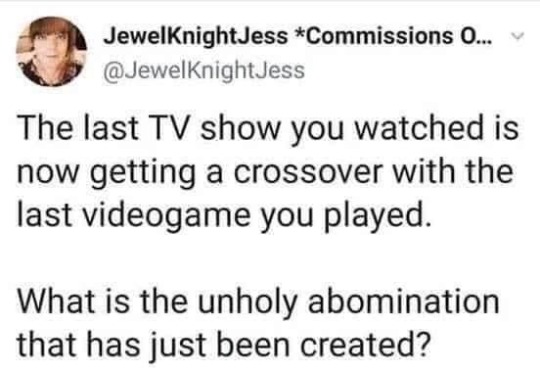
#I dont really know much about honkai star rail but its very well written and Im so intrigued#also would be so interesting if like Zelda's research aspect that her dad didnt approve of was about glyphs or smth#like the divine beasts or whatever they would be were made to only be activated by the titans magic#shekiah and yiga used to study glyphs and glyph combos but they broke off after the old kings got scared of wild magic#and the yiga continued practicing glyphs while the shekiah helped to establish the covens and became part of the emporers coven or smth
126K notes
·
View notes
Text
I wonder why no one ever used the super glyph from Escaping expulsion again
I mean, it's a strong spell that, if you don't know how to dispell it, keeps growing. (Though I think that Belos would have figured it out)
1 note
·
View note
Note
Idk if this is a huge request or not, but could you explain more about Bell? (The shitten in your au)
I would be thankful, take care.
Yeah, ive done like... 3 pieces of her max but she gets SO many asks lol. the story isn't really ready for her yet, and i'd like to finish what im working on before i do more with her, but i'll give the basic rundown.
she LITTERALY started as a joke baby post but she got so much interaction i said i'd expand on her design and now she seems to just have a following of simps (oops, like lamb like daughter)
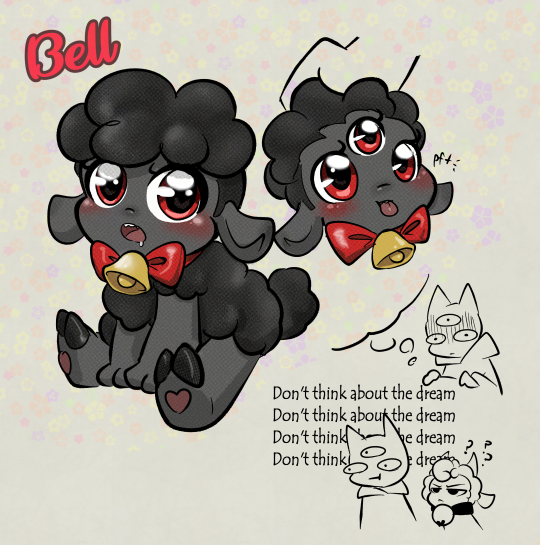
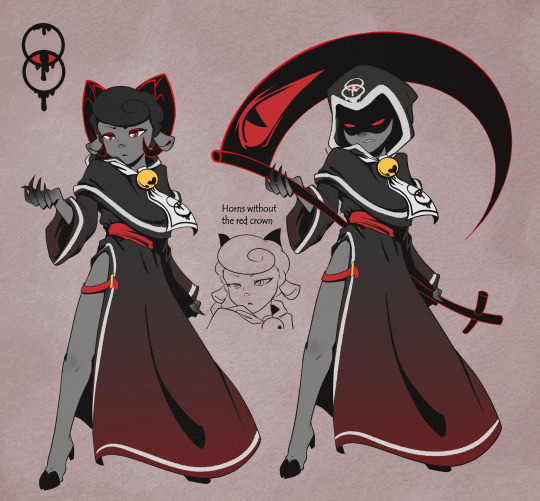
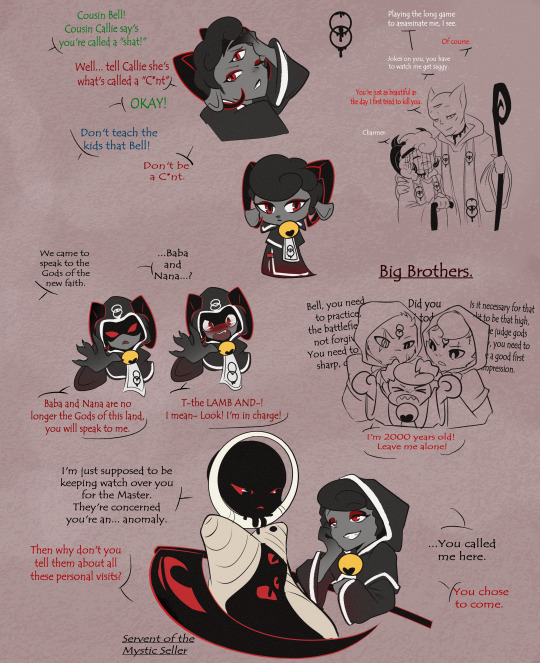
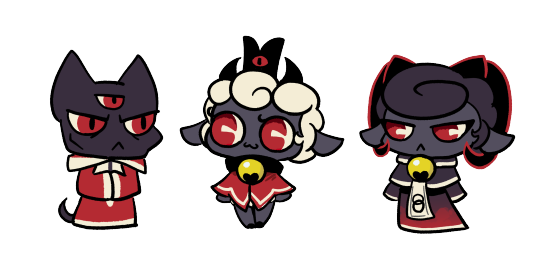
most of the old ideas for ewen and nari with her are out of date now on the art, but heres a bunch of plot and some unposted sketches under cut
Nari and Ewen are married and leading the cult still. all the siblings have kids, grandkids and even great grandkids (excluding shamura). Its only after they decide having a child is someone for them to love and raise, not someone who they're forcing the cycle of trauma on that they have Bell. And they adore her. While growing up, one by one, the former bishops, all her aunts, uncles, and shamura decided it was time to peacefully end their long lives. So she sees death as a good thing, the satisfying end to a long life story. So when Ewen and Narinder are ready to die together, even though they say she doesn't have to, she takes on the crown and ends if for them with a last "i love you" between them. She runs the cult now which is more themed around their shared neck wound "rings" and their relationship than just the lamb. She's called "the black sheep" by her followers (or queen if they're kinky, princess when shes younger). she wields the crown as a pair of horns and a sythe, sine the cult of the black rings also referenced Ewen's large black horns and she keeps up the theme.
Baal and Aym are her "brothers" (more of her body guards and technically her cousins but she refuses to call them anything else) and her body guards, staying after their master's death. They've known her since she was a baby and still treat her as one sometimes. She's VERY protective over them, but also will bully them sometimes, like kicking their asses when training and saying they're just going easy on her like when she was a kid, knowing full well she's overpowered by the crown.
Because shes such an oddity, the mystic seller assigned one of their followers to keep an eye on her and, much like her "ba ba" she found the overpowered demigod shes now obsessed with. With some help from Ewen before they passed, they were able to translate their glyphs. Now that helper follows her around disguised as a poor imitation of a regular mortal to better understand her and the mortal realm. Or at least thats what she convinced them to do since she wants them around <3 probably not to their masters liking lol. I haven't decided on a name yet. Bell eventually give them the purple crown (they/it)
Before they left, Narinder was trying to reawaken the crowns, whether for the memory of his siblings, or that the cult was growing too large to be centered on the red crown. They're not very powerful right now and Bell is the leader of the others, more like a babysitter.
The blue crown is with Kalliope (kalli for short) (she/her), a distant relative of Kallamar's who had to fight, both physically and socially, with all her other of age relatives to get the chance, since Kallamar's polycule made a LOT of kids and grand kids. She's kind of bitchy about it and whines about everyone not respecting her or how hard she worked. shes a flamboyant cuttlefish and trans femme. also the crown is worn like an earring. Bell has little tolerance for her and they have a lot of bitchy girl fights.
The green crown is with isop (a kinda combo of isopod and aesop) (he/him) who is a rubber ducky isopod. he's Leshy's great great grandkid, and really only god the crown because no one else on the peaceful forest farm leshy put together in his later years really wanted it and figured it meant free babysitting. he's pretty young and small with a fascination for chaos and violence that only little kids without developed social perception can have, though he more watches at this point. The others tend to carry him or he rolls around in a little ball. The crown is worn like glasses.
The orange crown is with Mycelia (lia for short) (they/them plural) who is a homunculus mushroomo made through experimentation by Heket and Sozo before they died. they're the only one who is actually older than Bell. They're undying because they're a hive mind of all the mushroomo, who have been progressively growing. They can see everything the others see, can spout new bodies when needed and even feed on their own dead bodies. Bell sometimes just kills them when they're frustrated with them or other things. They'd be a threat but they're very monotone and emotionless about pretty much everything and don't care. They've worked with the red crown just because death is a natural boon to fungus and keeps them alive. The orange crown is worn as a necklace.
Heres some sketches since I haven't been able to get the designs to my liking but people keep asking so :T

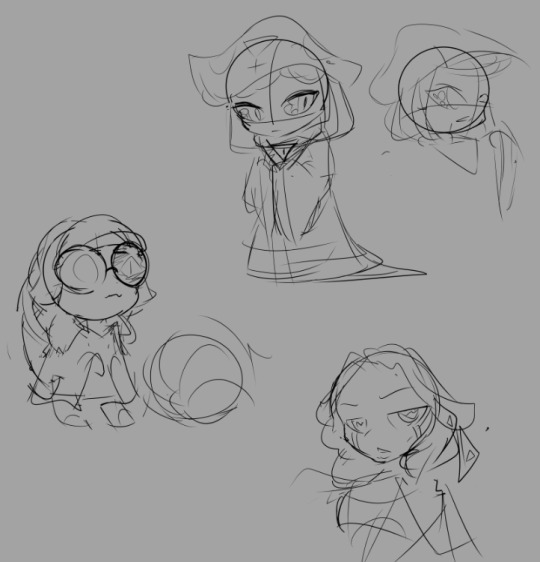
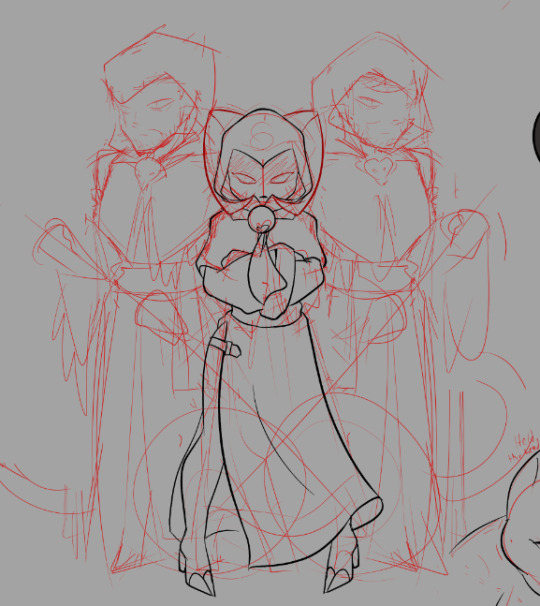
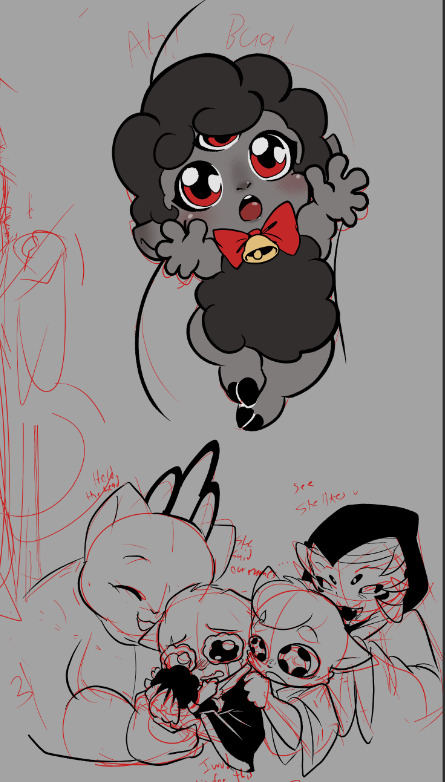


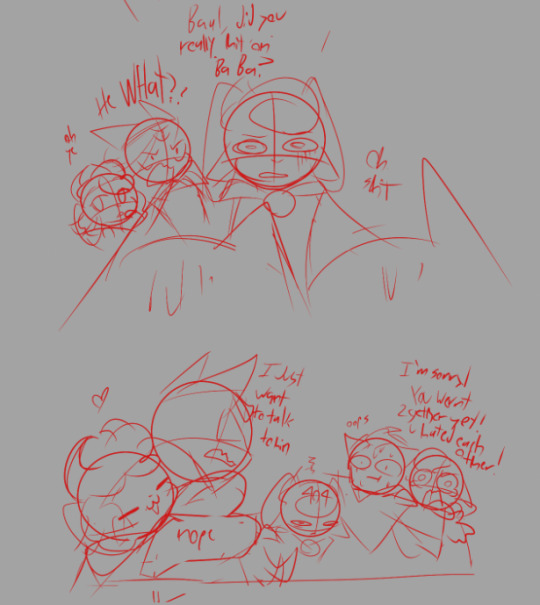
446 notes
·
View notes
Text

So me and @rev-pirate cooked up a RWBY au...
We have SO much for it already but essentially we looked at divorce quartet, said: is anyone gonna make them worse?" And then didn't wait for an answer
Quick synopsis- (and if you have no idea what rwby is, the main things you need to know is weapons have multiple forms, semblances are basically their superpowers, dust is a magical sunstance that can be used to enhance weapons, and they all go to this university and get put in teams of 4 to learn how to fight monsters called Grimm.)
-Martyn-
Nobody expected Martyn to be the leader, least of all him. He doesn't see what the headmaster does, and he won't until it's much too late for his team.
Weapon: electric guitar/axe
Semblance: Attacks are stronger when landed to the beat of music. The longer the combo, the higher the strength (He has trouble keeping rhythm without listening to music, which is why he always has his headphones near.) (Yeah just think hifi rush we hit him with Chai beams)
-Cleo-
The de-facto leader after Martyn decides team J.T.R.B are much funner to hang out with, Cleo is forced to attempt to keep a collapsing team from breaking apart. At least before graduation.
Weapon: staff/nunchucks/twin SMGs
Semblance: They can create decoys of themselves or other living things anywhere in sight. Now usually these would be illusions. But in combination with something called Dust in this universe they can be made solid. Which works really well in conjunction with Martyn's semblance. In that if given the opportunity they can make decoys that Martyn can hit to not break his combo between enemies. or to build a combo before going in for the strike for higher damage off the bat. Unfortunately for them. This team is doomed
-Scott-
As the heir of Aeor dust company, the leading supplier of the world's dust, graduating from a huntsman academy should have been one of the easiest tasks to accomplish. Little did he know...
Weapon: wooden longbow with dust enhanced arrows/staff
Semblance: glyphs (yeah he's basically Weiss LOL) The magic glyphs can spoil different things when infused with dust, like a speed or jump boost, and summon avatars of previously defeated Grimm out of dust.
-Pearl-
Pearl thought the worst thing that could happen was her classmates finding out she's secretly apart of the white fang. Turns out she hadn't planned to be grouped up with the heir of the white fangs biggest enemy.
Weapon: scythe/twin sickles/boomerang
Semblance: Anti-gravity. She can levitate any nonliving thing she's touched and control it. Used with gravity dust enhances this, allowing for her to control her weapons without needing to touch them. (As she grows stronger, she'll be able to control more things)
ALSO THIS POST IS SUPER LONG ALREADY SO have some weapon doodles as a treat, next team post soon

#If you have any questions for me or rev throw them in my inbox!#anyways#hi#this is where ive been ig LOL#mcyt au#double life smp#trafficblr#dlsmp#martyn itlw#zombie cleo#scott smajor#pearlescentmoon#divorce quartet#dlrwbyau#we did not think of a name for this au can you tell#rwby au#and again shoutout to rev i basically just copy/pasted everything he said from discord LOL#mcyt fanart
289 notes
·
View notes
Text
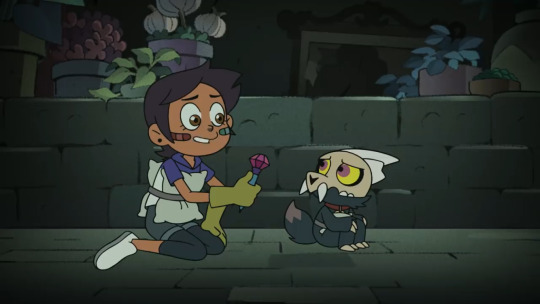
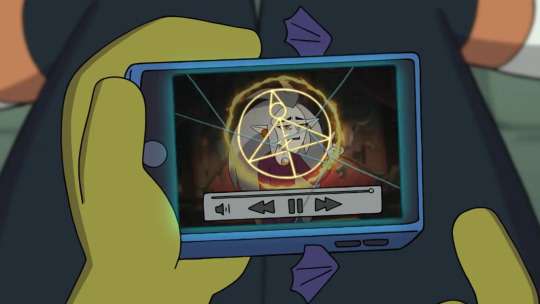
Thinking of how the Titan showed Luz the first glyph, Light, because she was kind to his son and listened to him, made him feel like his interests mattered when so many others overlooked the little guy and didn’t care about people like him. He didn’t force Luz to painstakingly find it on her own, as Philip did; The Titan freely gave this to her.
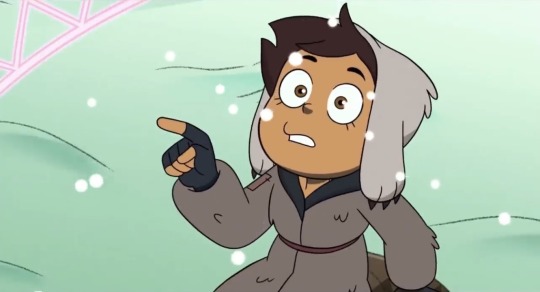
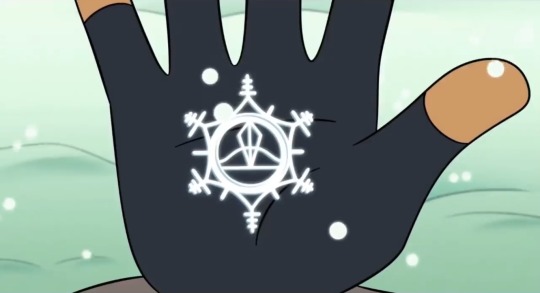
Then the second glyph, Ice, comes when Luz takes the moment to listen to the Titan; To say that she’ll learn on his terms, she’ll respect his body and work with him. Luz paid attention to the unheard son, and now the parent, speaking with and not for him as Philip did.
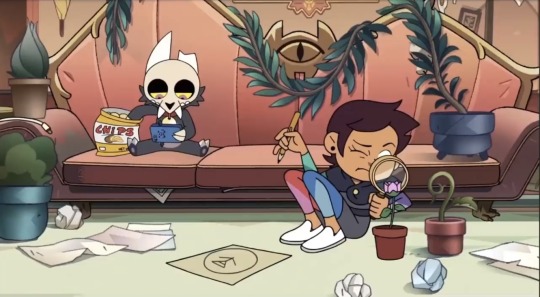
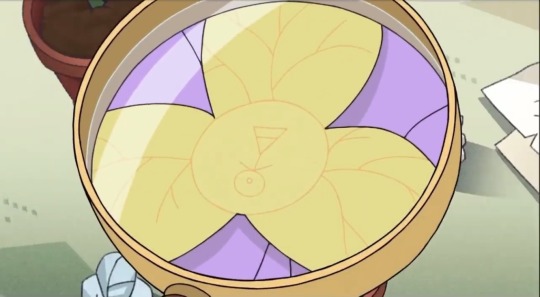
She gets the Plant glyph afterwards by continuing to follow that principle and give his son fun and company...
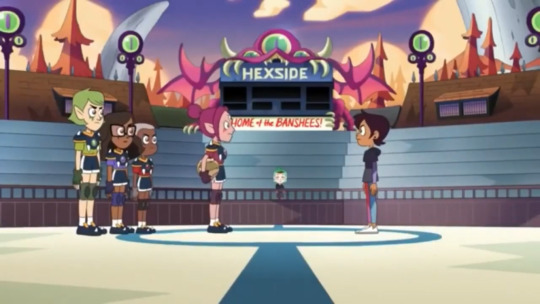
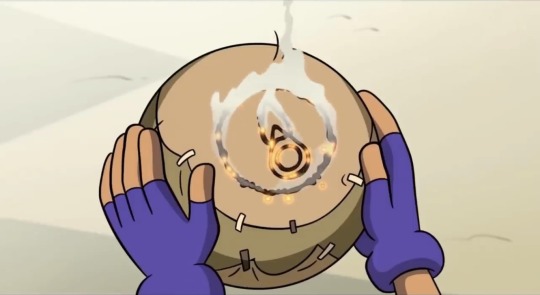
And the final glyph, Fire? Wing it like Witches is a major epiphany for Luz’s development, where it really hits her that she can’t drag her friends around in her attempts to play out certain beloved tropes and story beats she grew up on; In particular, this episode was about her desire to be the underdog hero, dragging Willow into relatively high-stakes consequences for a Grudgby match she did not ask for.


Sound familiar? I wonder if the Titan was low key afraid of Luz following in Philip’s steps, recognized that similar hero complex... Even if Luz was nowhere near as evil as Belos, well. Philip started off from somewhere, he didn’t begin as a genocidal dictator with countless sins to his name, he built his way up. Maybe the Titan is just being paranoid, Luz is so young after all! But in the end, he hid one final glyph from Philip because of his need for control, and it was admittedly Luz who jeopardized this precaution by giving Philip the Light spell.
Yet in Wing it like Witches, Luz really matures when she steps up and takes responsibility for her recklessness, for subsuming Willow’s problem and low key making it about herself, and what she decides for the group. Luz takes the full consequences of the stakes she set up so neither Willow nor Gus have to, and it’s this mature gesture of self-awareness that prompts them to reciprocate and forgive Luz.
So I wonder if THAT moment was what solidified to the Titan that yes, I really can trust this child. This human, the first after centuries of another who has been desecrating my corpse, bastardizing my name; She truly didn’t know any better, and meant well, teaching Philip the Titan’s last glyph. The first few glyphs were like little gifts, but giving Luz the last one meant she had full access to all of the Titan’s magic, so long as she experimented with glyph combos. And the Titan felt safe to entrust her with something he barred from Philip, because why?
Because Luz got over that fatal flaw of Philip’s; The desire to be the hero at any cost. That proved she wouldn’t follow in his footsteps, she diverged at a crucial point, and it meant she’d never become another Belos. They both worked and studied for the glyphs, but what mattered was the compassion that Luz had, and it was her kindness that began her discovery of glyphs. The Titan could trust his final glyph to her, Fire... But as he’d find out, it wasn’t even his final gift to Luz, either.
There really is this recurring arc of hesitancy from the Titan; Someone who was used, betrayed, and taken advantage of. And knew how easy it was for the same to happen to his son. So to see the little ways in which he opens up, recognizes Luz’s kindness and maturity and responds to each step in her growth... It’s like someone learning to trust again, realizing they’ve really found a friend after all. It’s no wonder Luz is treated like an old friend by the Titan, because she is one, and it makes his final gift and farewell to her all the more impactful.
On a lighter note! I’m just imagining the Titan figuring out how to show Luz the Fire glyph, after deciding he’ll do just that. I keep thinking of him watching Luz in the Grudgby game, cheering her on and giving Luz support by illuminating his last glyph in Boscha’s fire; “Here kid, take this!” It’s such a relatively casual and silly moment too, because the Titan isn’t obsessed with the theatrics and drama of godhood.
4K notes
·
View notes
Text
okay yeah let’s do blood magic ….. force magic my beloved I will come for you later
quick poll! should I take force magic or blood magic?
#challenging myself to do more ‘invisible’ magic this time so no chain lightning (sob)#which means my favorite combo of gravity well + paralysis glyph + chain lightning is a no#picking up lots of hexes and barriers
22 notes
·
View notes
Text

Everything is Alright pt 8
Soundwave x reader- whispers
• It’s just out of reach, that whispering tangle of confused emotions at the edge of his awareness. And he isn’t able to block them out like normal, so they’re just there, pulling at him. All the time. Except, no Cybertronian’s mind is this chaotic. Not even Skywarp.
• Fine hair at your nape prickling, you turn and stare out of your cage at the empty space around you. That eerie sense of not being along trips down your spine on icy fingers, leaving goosebumps in its wake. It’s not the first time you’ve felt the sensation over the last several days. Usually faint, it’s like a half-remembered word on the tip of your tongue. A memory you can recall the emotion for, but not the details. And it makes your chest ache even as it scares you.
• That voice whispers without words to you, calming your thoughts when you start to unravel from stress and fear. You haven’t dared mention it to Starscream. What can you even say? That you think you’re losing your mind? That you miss something so viscerally it hurts and you don’t even know what it is?
• No matter how many mental walls he puts up, it’s still there. Always there. Always just out of reach. Soundwave slumps at his console, glyphs running together as he tries to focus. He’s aware of his cassettes’s worry. They don’t share his gift exactly, but they’re all aware that something is wrong.
• It’s frustration that drives him from his office, leaving behind the monitors to stalk the halls. This has to end- this distraction. He drifts through the base, no longer trying to block that whispering mind out. Now he’s seeking it, a thrill of recognition sparking in him as he hesitates in front of the SIC’s closed door. This rotation, Starscream would be on patrol. No one to catch him override the lock and slip inside, because that chaos of needs and emotion is so close, warping sharply, painfully into fear as he steps inside the dimly lit space.
• Frozen, you stare at the boxy new mech and hold your breath. Given how Skywarp and Thundercracker had reacted to finding you hidden away like a favorite toy, you expect pain. Last time, Starscream had shown up just in time, but this time? You might not be so lucky and as its head turns to stare at you from a faintly luminous visor, you have to admit Lady Luck is a jerk.
• A human. The tiny creature stares up at him with frightened eyes, the noise of its thoughts increasing with panic. Becoming almost deafening. “Stop.” He’s reaching for it inside its crude cage before he thinks better and it cringes as he lifts it free. Never having been so close to one, he never realized he could hear them. Their thoughts a living thing, growing wild and chaotic- sharp and painful inside his processor. “Stop,” he repeats again, softening the demand as it trembles and he runs a servo from the bridge of its nose, up and over its hair, and it freezes. The touch startling it into blissful silence just like an anxious sparkling.
• That sense of familiarity washes over you as your heart races. It’s warmth and safety, that voice draining away the fear as he runs a feather-light finger against you again. Nerves still humming, you stare up at this new mech and wonder why you’re suddenly not afraid. Why you want to curl against his servos, because, like Starscream, he’s safe. As you blink up at him, his big shoulders ease slowly and that servo makes another pass, the touch making you lean away. That visor and mask combo make reading his mood from his expression impossible, but you don’t think he’s angry. He’s almost humming, the noise unheard but felt as it buzzes through your bones and you relax further.
• Finally. Finally he’s not drowning in those wild thoughts. He can’t even get a true read like he can on a Cybertronian, organic thoughts are all bright flashes of emotion and movement. But calm, it’s almost music, running constantly like the chatter of water. When it speaks, that soft voice surprises him. “If Starscream finds you here, he’ll be mad.” Those words skitter through his mind with more bright, anxious emotion. Fascinating. Afraid of Starscream? No. Worried about Starscream’s reaction. Worried for… him?
Previous Next
365 notes
·
View notes
Text

I imagined Philip's quarters have a little area where he can sit by the widow to watch the rain, even if it's not the same as in the human realm, and his bed would be in the room next to it. I think he also has a bigger personal library with (probably banned books on wild magic he studied lol) and a larger fire place with a much bigger couch too I also imagined that the entrance to his quarters would be kinda like the way the cave opened with glyphs, so it looks like a blank wall and only he can get in with the right combo he probably also has a spell put on the window (like an illusion maybe) so he can see the outside but people can't see inside his room from outside he probably has a bathroom towards the left too so like an en suite bathroom in his bedroom I think tho all of his really secret stuff aren't kept in his quarters, like the collector's tablet and the Grimwalker are are all separate from the castle entirely in the Titan's skull. I think he probably has some semi personal stuff in his quarters like maybe a journal or books he would considered banned books but he'd be careful to keep anything truly incriminating in the Titan's skull area behind the big gates
I've looked up so many refs from the show 😂 like I went to find how they designed drawer knobs in different rooms looool the kind of details literally no one else is gonna notice but I need it to be accurate 😂 these are the main refs I was looking at




(I know the second one is from the ship but it's still EC themed so I figured I could still have a look at the furniture and stuff for inspiration)
160 notes
·
View notes
Text
Luz and Amity: the power couple.
Luz and Amity are strong on their own, but together, they're unstoppable.
1. Grom dance.
They have never danced with each other before but they're so in sync. They know each other's next moves and dance seamlessly together. We see their magic combination for the first time: Amity's Abomination with Luz's plant glyph. Together, they create the beautiful Grom tree, a symbol of their blossoming romance.

2. Grudgeby match.
Luz and Amity's tag team! They win a score together.

3. Fight against Kikimora.
Two of Luz's glyphs can be combined with Amity's Abomination, the plant and ice glyphs. I'd love to see more of their magic combination, even magic training together.


I love how supportive Luz is towards Amity in this episode.

4. Any Sports in a Storm.
They take turns to get Tinella Nosa.
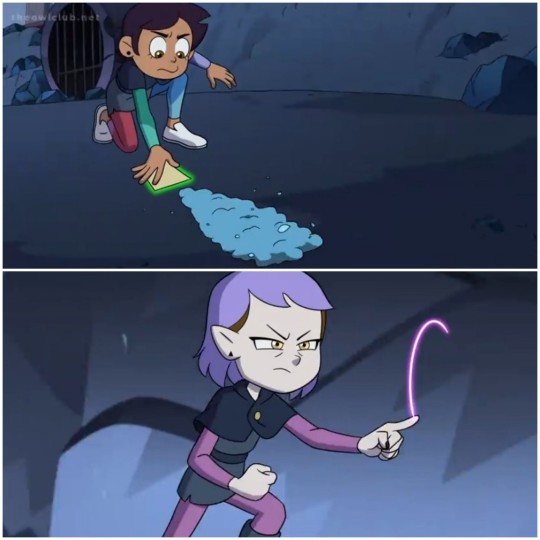
5. King's Tide.
I love their magic combo so much. Their magic works so well together.

162 notes
·
View notes
Note
In your Gravity Falls/Owl House au: how is Stan with magic?
I can see Ford being strong with magic but he is more books mart about it, while Stan is strong with it but comes more naturally to him.
I know Eda is her own character and everything but I imagine Stan being like her in the way she is naturally strong and gifted with magic.
Both the twins are humans in the au! Ford discovered the glyphs and got REALLY good with making glyph combos! Stan’s scar on his back is from him getting pushed up against a glyph combo and it activating violently against him. Ford has a palisman as well but he didn’t use it as often as its abilities were more limited, and he was more interested in the things he could do with glyph combos. (Uh ask me if you’re interested in my headcanons on the difference between glyph magic and palismen magic)
Stan actually gets by chiefly using potions or contraptions! Outsourcing the work like any good business man o7 it’s also a bit of a laying low thing haha. After the reveal he’s more liberal with his magic usage which is mostly working with his palisman Alcatraz. Stan is really knowledgeable with Glyphs (since he’s studying them to try and replicate the glyph portal) but he’s not very good with thinking up combos on the spot (Ford is really good with that)
Uh at least that’s what my gut says rn - always could change lol
112 notes
·
View notes
Text
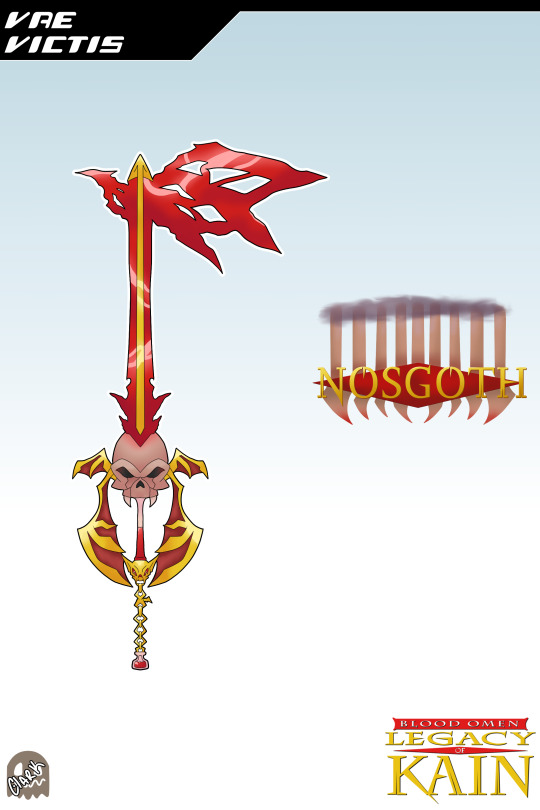
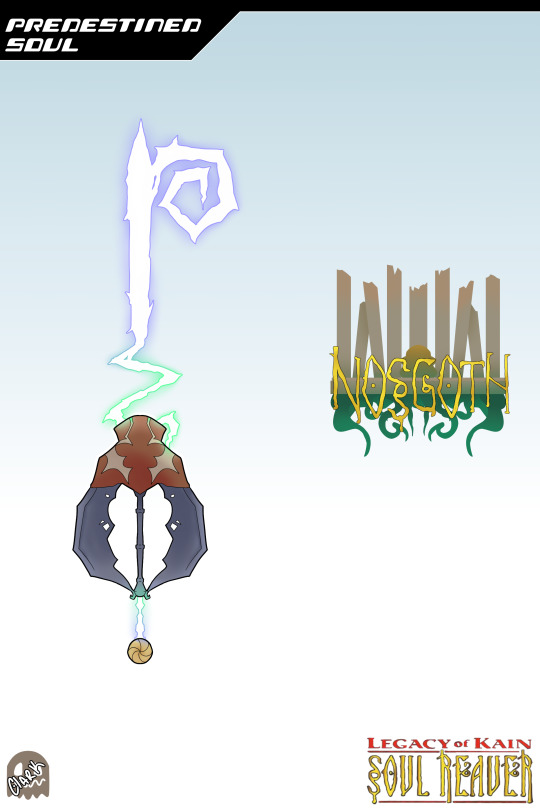
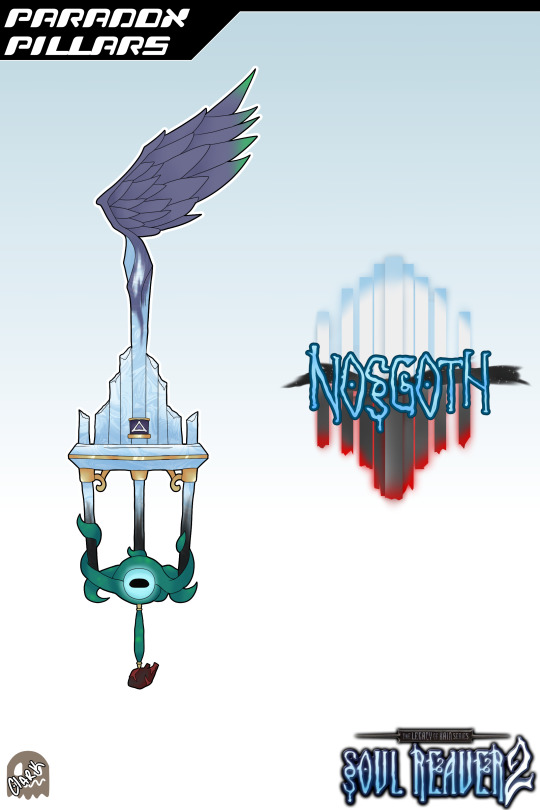
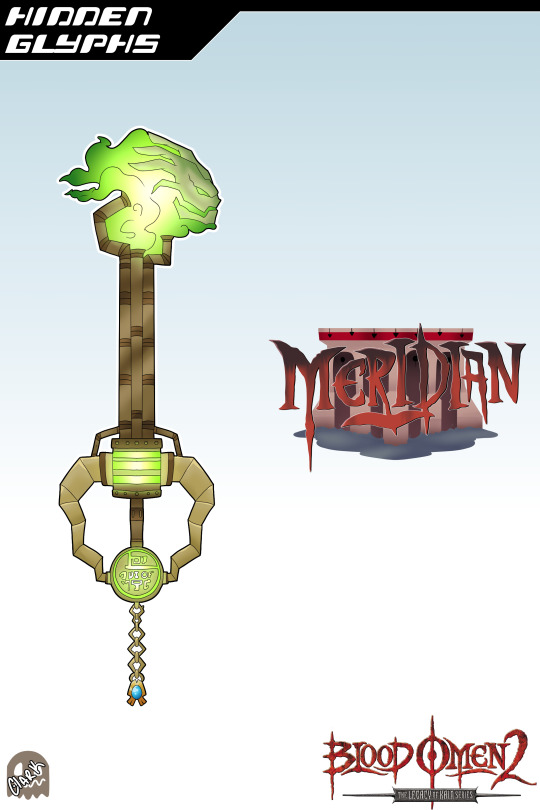
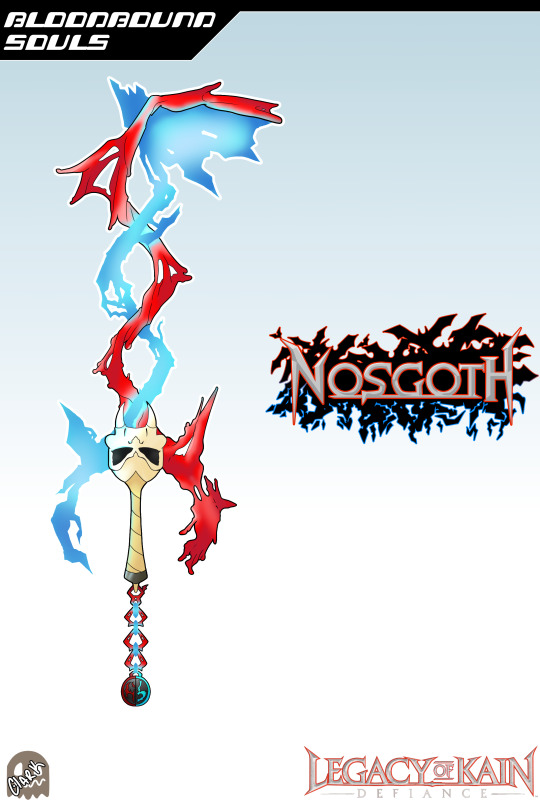

The next set of Halloween Keyblades are done! This time we go to Nosgoth with Blood Omen, Soul Reaver, Soul Reaver 2, Blood Omen 2, Defiance, and Nosgoth!
Special shoutout to @INazeerudin for sending me to this series!
VAE VICTIS-
A Keyblade modeled after the bloodiness of Blood Omen: Legacy of Kain! This Keyblade is designed to increase the amount of health drops a target has! The handle is designed after a blood vial, and will move as the blade swings. The hilt guard is designed after the skull of the Soul Reaver, with various gold bat designs found in the menus of Blood Omen. The Shaft of the blade is designed after the Blood Save Alters found in the game, with the "blood" portion of it forming a bat-like wing for the teeth. The token is a blood health potion. The world logo shows the Pillars of Nosgoth, with various vampire fangs beneath. The name of the keyblade comes from the line that Kain would often say, death to the conquered.
PREDESTINED SOUL-
A Keyblade modeled after the amazing look of Raziel from Legacy of Kain: Soul Reaver! This Keyblade is designed to increase the lightning damage from spells. The crossguard is designed after Raziel's scarf, with the sides being his tattered wings. The shaft of the blade is designed after the Wraith Blade, with the teeth being a representation of Raziel's health UI. The keychain follows the same look of the Wraith Blade, with the token being the health upgrade. The world logo shows the destroyed Pillars of Nosgoth with the Elder God beneath it.
PARADOX PILLARS-
A Keyblade modeled after the pillars of Nosgoth as seen in Legacy of Kain: Soul Reaver 2! This Keyblade is designed to have Time Stop last longer. The hilt guard and shaft features the destoryed pillars, with the Pillar of Balance being front and center. The pommel and bottom of the hilt is the Elder God gripping the pillars. The shaft of the blade, formed of the Pillar of Balance, forms into the wing of Janus Aldron to form the teeth as well. The chain being that of another tentacle of Elder God. The token being Janus Aldron's Heart of Darkness. The world logo shows the prestined Pillars of Nosgoth, as well as the corrupted and destroyed pillars. The name comes from the fact that Raziel continued to become a paradox, as well as the various pillars.
HIDDEN GLYPHS-
A Keyblade modeled after the Glyph technology seen throughout Meridian in Blood Omen 2! This keyblade is designed to have high knockback on enemies. The entire keyblade is designed after the various piping and technology powered by the Glyphs used by the Sarafan. The teeth of the blade is the gasous form of the Glyphs with the head of the Hyldan. The token is that of the Nexus Stone. The World Logo is that of Meridian, where most of the game takes place. The name comes from the fact that the Glyphs hold a lot of secrets.
BLOODBOUND SOULS-
A Keyblade modeled after the dual nature of Legacy of Kain: Defiance! This keyblade is designed to have life steal and can stun a target. The hilt of the blade is designed after the Soul Reaver, with a dual helix of Raziel's Soul energy and Kain's blood powers. The helix forms a wing for the teeth. The token is a half and half symbol combining both vampire's symbols. The world logo has a combination of bats and soul frays. The name comes from the fact that Kain was the one to turn Raziel into a vampire (Bloodbound), and their souls seemingly are tied by faith.
DEATH TO THE DEAD-
A Keyblade modeled after the elements of the cancelled Nosgoth game! This keyblade is designed to have extended combos. The hilt guard is designed after the Nosgoth pillars logo, with the shaft of the blade being from the Key item found for the external chests. The teeth of the blade is designed after the Rune symbol. The token is said Rune. The World logo has the symbol of both the human hunters and the vampires. The name comes from one of the achievements of the game, as well as the fact that the game is cancelled.
#Kingdom Hearts#Keyblades#Crossovers#Legacy of Kain#Blood Omen#Blood Omen 2#Soul Reaver#Soul Reaver 2#Defiance#Nosgoth
47 notes
·
View notes